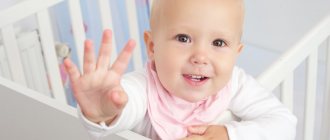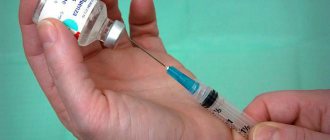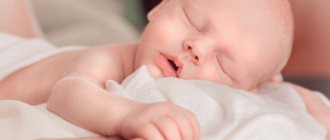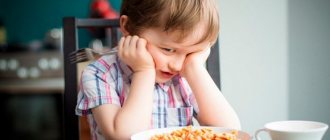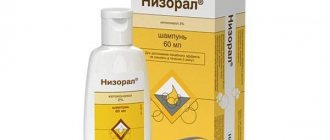5581 0
- Development of an infectious disease
- Infection prevention measures
- Isolation of the patient
- Reduced microbial load
- Disinfection
- Personal hygiene measures
- If the baby's mother is sick
Family is a society, constant communication and contacts. What to do if someone around your baby gets sick?
Knowing this, it is easy to understand the main preventive measures, which can be grouped as follows.
Are common:
- Separation of contacts or maximum distancing from the patient
- Reduced microbial load
- Disinfection measures
Individual:
- Personal hygiene using barrier products
- Irrigation of mucous membranes
- Immunization (active and passive)
Let's look at each of them.
Step one - isolation of the patient
A person with catarrhal symptoms (runny nose, cough, lacrimation) is a source of infection for others.
Therefore, the first step in preventing infection of other family members is isolation. It is especially important to prevent the patient from interacting with infants. A set of measures aimed at isolating patients, contacts and carriers is called quarantine. It is clear that in small apartments where several generations live, isolation is difficult. However, you can protect the place where the patient is, and also maintain the maximum possible distance when communicating with him.
Separate linen, towels, dishes, personal hygiene items, etc. should be provided for the patient.
It is important to create conditions to minimize the release of microbial particles into the environment by providing the following:
- Possibility of changing the patient's mask every hour
- availability of hygiene products (napkins, handkerchiefs, etc.) and a place to collect them near the patient
- daily linen change
Step two – reducing the microbial load
Ventilate the room as often as possible. Do wet cleaning at least twice a day. These measures do not kill infectious agents, but significantly reduce the risk of getting sick.
How to quickly treat a cold
During seasonal outbreaks of the disease, prevention of colds in infants is important: rinsing the nose with sea water removes pathogens from the mucous membrane and protects the baby.
With a normal ARVI, it is necessary to actively feed the baby compote, herbal tea, and plain water. This is especially important when the temperature rises, when the child naturally loses a lot of moisture.
It is advisable to constantly moisten the nose and throat with salt water, rinse the mucus, and remove crusts. This procedure creates optimal conditions for the work of local immunity; it is he who is able to stop the disease and not allow it to continue.
Treatment of colds in a child 3 years of age and older involves taking antipyretics in the form of syrups, teas, tablets; rectal suppositories are suitable for children. It is important that the temperature in the room where the child is located is in the range of 18-20 degrees, and the air is sufficiently humidified.
How it works?
There is such a concept as “infectious dose” - this is the number of microbial bodies necessary for the development of an infectious process when it enters a susceptible organism. When we ventilate or do wet cleaning, microbes are diluted in a large volume of air or liquid. As a result, even when in contact with infectious agents, a person does not get sick. When wet cleaning, you need to wipe not only the floors. Don’t forget about door handles, chair backs, taps, remote controls, gadgets, etc. All horizontal surfaces and objects with which there is frequent contact need careful treatment.
Disinfection
This is a set of measures to disinfect a room using agents that destroy pathogenic microorganisms. If you have special solutions and/or devices, you can use them. This should be done once, at the end of the day. These can be chlorine-containing agents, quartz lamps, air filters, etc. It should be remembered that their use has a number of restrictions and requires strict adherence to the instructions (concentration, exposure, frequency) and compliance with safety precautions.
Personal hygiene measures
Personal hygiene measures such as hand washing, gloves, masks and nasal filters are applicable for children over 3 years of age. They are not suitable for babies. Relevant for kids:
- daily hygiene procedures
- balanced diet
- sleep and walks.
It is worth paying attention to products containing probiotics such as LGG and BB-12, which have the largest evidence base for the prevention of infections in children.
Important! Change bedding every day. Wash it at temperatures above 60 degrees.
Irrigation of mucous membranes
You can use plain water for the eyes, and special prophylactic salt solutions for the nose, or prepare it yourself (1 teaspoon of salt per 1 liter of water).
It is better to discuss the use of medicinal ointments and solutions with your treating pediatrician. There are no studies that have proven their clinical significance in the prevention of respiratory infections.
Dropping breast milk into a baby's nose and eyes is not effective. Yes, there are many protective factors in breast milk, but all of them are intended for the gastrointestinal mucosa. Putting breast milk in your nose is like washing your face with cow's milk. We washed ourselves and left it to dry on ourselves. Shocking, but pointless. Just imagine this picture and everything will become clear.
Immunization
This is a way to prevent the spread of infectious diseases in two ways:
- introduction of vaccines
- administration of specific immunoglobulins
A vaccine is a weakened microorganism or its particles.
In response to it, an active immune response is formed by the body itself. Vaccination is a long way to develop protection against infections. If the baby is vaccinated, then contact with the sick is not so scary for him. If there has been no vaccination, and the risk of disease is high, then there is another option to protect the child from the development of the infectious process. In this case, ready-made antibodies to certain pathogens are used. This procedure is carried out only for medical reasons.
Patient care
It is advisable that the care of the patient is provided not by the child’s mother, but by other family members.
How to find out what exactly hurts a child - pediatric neurologist
“When we prescribe minimally invasive medical procedures, for example, such as a general blood test,” says the doctor, “mothers always ask: do it so that it doesn’t hurt.”
You and I are all afraid of pain. It is not just a physical phenomenon for us. Pain can be imprinted in our memory and periodically remind us of itself. This is a multi-component experience.
There is, for example, social pain: “How will society perceive me if I have pain here?” Then mental pain forms. There is also a type of pain called neuropathic, associated with damage to the nervous system itself .
There is a psychological component to pain. For example, when they take a blood test, and how psychologically I will perceive its result. Will he be bad or good? Therefore, according to the definition of the International Association for the Study of Pain, pain is a complex that is an unpleasant sensory and emotional experience associated with actual or potential tissue damage .
A blow, a word, shock, mental hostility - all this shapes the body’s perception of the components of pain.
“But we, doctors,” continues Pushkarev, “more often encounter the nociceptive type of pain, that is, associated with damage to the tissue itself and activation of pain receptors (nociceptors). For example, pain from hitting your fingers with a hammer, from being cut by something sharp, or pain from appendicitis, when this sensation occurs due to damage to the appendix.
And so, as a pediatric neurologist, I don’t quite understand why some theorists believe that children do not perceive pain, supposedly do not feel it, especially in the first three months of life. Actually this is not true.
Babies cannot talk about it and just cry. What does a mother do when her baby cries? She holds him close to her, begins to rock him, then gives him the breast. If he doesn't calm down, she starts feeling him. He notices that he is hot, which means he has a fever. That is, the mother again appeals to different components of pain .
When she puts the baby to the breast and begins to feed him, his taste buds are activated, he is distracted, because milk still contains substances that at that moment anesthetize him.
In addition, the smell of mom is added. She begins to talk to the child, trying to calm him down.
But in this case, mom is stressed. And this adrenaline, the hormones of excitement that women accumulate throughout the day, is transmitted through milk . And the child’s level of excitement may increase. Then dad comes home. And he does not have a pronounced parental instinct. During the day, dads are busy with completely different things. They are more balanced and calm.
In addition, during the day, dad accumulates a certain percentage of testosterone, which is then transmitted to the child through breathing and communication. And when dad takes care of the baby, what happens? The child calms down.
And after a while it goes back into the hands of his mother. And by that time all her stress had already gone, and she feeds the baby calm milk, without adrenaline and other stress hormones. This stage of pre-medicinal pain treatment is called self-regulation.
Balance in everything
So, we calmed the baby down and, it seems, there is no need to give him anything else. But then you note that he still has a fever. You begin to unsolder it and measure the temperature. From breast milk and calm communication, she has already decreased somewhat. And now you have the opportunity to soberly assess how critical the situation really is. Here, it is probably possible to use drug treatment, according to the protocol of the World Health Organization (WHO).
For use in pediatric practice, WHO recommends paracetamol and ibuprofen, which are also called “1st step analgesics in children.” They are included in the children's first aid kit, according to pharmaceutical care protocols.
However, as practice shows, the analgesic effect of paracetamol in many children, especially infants, is weakly expressed, and the anti-inflammatory effect is sometimes completely absent.
In such cases, the only drug approved for children from three months of age, ibuprofen . Its triple effect provides a decrease in body temperature, pain relief and a reduction in inflammation.
“And in our case,” says Dr. Pushkarev, “I would like to talk mainly about the group of ibuprofens in comparison with paracetamol. Although both of them belong to the category of non-narcotic analgesics, which are dispensed without a doctor’s prescription for inflammatory pain.
But I believe that paracetamol is more nephrotoxic. It can affect the gastrointestinal tract and has a risk of overdose compared to ibuprofen and does not have an anti-inflammatory effect.
But pain is usually accompanied by inflammation. Now, if a child hits himself, this place will not only hurt, but also become inflamed.
According to WHO recommendations, paracetamol can be given to children from any age . But in the varieties of the drug available on the market in Kazakhstan, on average there is a sufficiently high concentration of paracetamol, at which use in early childhood will also be prohibited.
For example, you cannot give Panadol for up to two months, and the popular efferalgan is not recommended for up to one month. Tailol is prohibited for up to two months. Please note that all of these drugs are available without a doctor's prescription! That's the problem!
And any mother can come to the pharmacy and... Here it is up to the competence of the pharmacist, who can recommend this particular drug to her or not. The pharmacist needs to sell the drug. Therefore, I am in favor of children being prescribed such drugs by a doctor and in a strictly defined dosage. How to properly treat babies with high fever
And I consider the use of ibuprofen safer, since this drug accumulates quite quickly in the blood and remains there for a long time - up to 24 hours.
Mom sees its effect faster. I’ll explain how important this is with examples.
Rectal suppositories - where are they?
Too often, children with overdoses from any drugs from all over the city and from the Almaty region are brought to the toxicology department of the Center for Children's Emergency Medical Care in Almaty. And this is most often due to the indiscriminate use of medications by mothers .
She gave one, waited 10 minutes - as if it didn’t work, gave a second, a third. I forgot to tell the ambulance doctors, they gave me another injection. As a result, the child feels very bad.
And he is brought to the clinic with bleeding, and we begin to treat him and relieve intoxication. So, when using ibuprofen, the effect of which is detected immediately and for a long time, you can avoid this indiscriminate use of other drugs. There is a dose, there are hours. Please comply. If it doesn’t help, you should always see a doctor, recommends Konstantin Pushkarev.
Well, we, doctors, pediatric neurologists, are based on three basic principles. First, if a child has pain, the analgesic should be given at regular intervals , by the hour, according to the instructions of the drug, and not as needed. While strictly monitoring side effects. Unfortunately, these effects do happen. Let's say an allergic reaction . And this is not the doctor’s mistake. Each person's body is individual. Someone can get anaphylactic shock from banal valerian simply because, roughly speaking, he is allergic to it. Therefore, when giving the drug, we monitor the child’s reaction and only then, gradually, begin to treat him.
What kind of pain is the child experiencing?
The pain can be acute, shooting, monotonous, chronic, progressive, causing pain. And, by the way, a person then gets used to it. In this case, it is necessary to prescribe him additional antidepressants if the person’s brain remembers this pain and periodically repeats it.
“But this is in adults,” the neurologist comments, “but how can we determine the type of pain in a child?” After all, it's not easy.
This is why the popular pediatric pain rating scale was developed. These are such emoticons. When the baby experiences pain, he points to the corresponding emoticon, how much he does not like this pain.
I still can’t understand how it was possible to develop such a scale so that the child would indicate exactly a specific picture. But in reality it works. And it is used for children over 7 years old.
When treating infants, pediatricians often pay attention to the baby’s behavior, for example, his crying. Mothers sometimes ask: “How do you know that he’s crying there?” “I know, because he somehow doesn’t move his arms properly, refuses to breastfeed, and breathes frequently. The child develops a kind of Purple cry - “purple cry”, purple syndrome, when it is impossible to calm him down . In this case, I establish the degree of pain using certain scales and begin to treat him specifically for the pain syndrome. Calming with medication, I move on to the next steps according to WHO recommendations,” the neurologist shares his experience.
How to take medications for children
Drugs are administered to children in different ways: intravenously, rectally, intramuscularly and through the skin . When assessing the clinical situation, the most accessible of them is selected. At the same time, according to WHO theory, the intramuscular route of administration should not be used in children, because it is very painful. Pediatricians avoid him. Dosage forms are administered intravenously or intramuscularly to children only in emergency situations.
But the oral method of taking drug solutions, that is, through the mouth by swallowing, is the most relevant in pediatric practice, and it comes first. Because this is the least painless, simple and effective way. However, oral solutions should not contain sugar or alcohol to avoid causing negative effects.
The rectal method of administering medications is also very convenient for children (into the rectum through the anus, where they are absorbed by the circulatory system). These are rectal suppositories, with which the child does not experience discomfort. Only when prescribing rectal suppositories, the pediatrician, of course, must explain to the mother where to put them.
– We have many different holes in our bodies. Some parents begin to chuckle quietly at this,” says Pushkarev. - But we have no time for jokes. In my practice, there was a case in the neonatal pathology department at the first children's clinic.
I explained to my mother: “Light one candle twice a day.” We made rounds there every three hours. And then I look, and the child has something sticking out in his nose! And the department is quite difficult. I take the ear stick and pull out the rectal suppository!..
And then I remember all the stories and jokes on this topic. How do patients begin to swallow or burn such suppositories? And all this is in real life. Therefore, we, doctors, really need to explain to every patient that a rectal suppository is placed in the anus, and taking the medicine orally is through the mouth .
“There is another misconception,” the doctor continues, “that we must prescribe drugs according to dosages. But if we see that the child is thin and small, then we will reduce his dosage . Over the 7 years of working in the neonatal pathology department, neonatologists trained me well in this. They do everything based on body weight. That is, a 500-gram child needs one dosage, and a large one needs another. In pediatrics this is how it is determined – per body weight and per year of life. For each child, treatment should be selected individually. Kids are poisoned by dozens of sewer cleaners and cauldrons
And here’s another note for mothers.
The popular aspirin is a good drug, it has analgesic, antipyretic, and anti-inflammatory effects. But not for small children! It can only be used after 15 years. Or a drug such as analgin relieves pain and reduces fever, but is not anti-inflammatory.
And the last thing I would like to say. Since 2003, Kazakhstan has launched the WHO program - Integrated Management of Illnesses in Children under 5 (IMCI), which has really helped reduce mortality and stimulate children's self-regulation. So it says: if a child cannot drink or suckle, if he has a cough and difficulty breathing, vomiting or diarrhea, fever, which will then be accompanied by convulsions, or already has convulsions, then you need to not just give drugs, but call “ ambulance! Or invite a doctor to your home, who will assess the child’s condition and responsibly tell him how to treat him.
ALMATY
Colds in infants and possible complications: care, care, treatment
Colds in infants: creating conditions for recovery
The room in which the sick child is located must be ventilated several times a day.
In summer, you can generally keep the windows open all day: the sun and air kill a significant part of the germs. In winter, it is better to take a sick child into another room while airing. If this is not possible, then the baby should be wrapped in a warm blanket, his head should be covered with a hat, and the bed should be placed so that it does not fall into the flow of cold air. Neither a runny nose, nor a cough, nor a high temperature should interfere with regular ventilation. The optimal room temperature for babies is 21–22 °C. At least once a day, the room where the sick baby is located should be wet cleaned. A sick child's clothes should be light, comfortable and spacious, so as not to cause him unnecessary anxiety or impair blood circulation. Preferred clothing is made of cotton fabric, which is highly breathable and absorbs moisture. You can only warm your baby if, despite the high temperature, his skin is too pale or has a marbled tint. This is explained by a spasm of blood vessels, and in this case, warming will help eliminate this spasm, dilate the blood vessels and release heat. If the baby sweats, then each time he needs to be wiped dry and changed into dry underwear. If your baby is wearing diapers, be sure to check and change them often. A sick baby's underwear needs to be changed daily, and bedding when soiled.
Colds in infants: the correct daily routine
The regimen for a sick child depends on his age, severity and stage of the disease, treatment methods, character traits and individual characteristics. Some children get tired faster, others more slowly, some are calm and even lethargic, others are excited and irritable. But in general, during illness, all children quickly get tired due to still weak adaptive capabilities and rapid exhaustion of the nervous system, so during this period the child needs a calm environment. A sick baby, more than a healthy one, needs proper rest. It is advisable for him to sleep as much as possible. This will have a beneficial effect on the child’s healing process.
Positive emotions are of great importance for the child’s recovery, so try not to show your excitement. Do not forget that even the smallest children very subtly grasp the psycho-emotional state of their parents.
Colds in infants: why bathing is necessary
Parents' fear of bathing sick children is completely unfounded. The fact is that in young children the respiratory function of the skin is highly pronounced. The usefulness of baths lies in the fact that they significantly alleviate the child’s condition: clean skin better performs its respiratory function and thereby helps to provide the child’s body with the necessary amount of oxygen. It is also important that at high temperatures, a bath with a water temperature 2 °C below body temperature helps to reduce the temperature and can be regarded as a therapeutic effect. Therefore, if there is no doctor’s prohibition, you need to bathe children every day.
If the body temperature is low, the bath is made at normal temperature or a little warmer (36–37 ° C). Children need to be washed as usual. Baby soap, foam or bathing gel for babies should be used 1-2 times a week. It is very important to remember the main thing - not to overcool the baby, so after bathing the baby, dry it with a warm thin sheet or towel (blotting motions, without rubbing, since the skin of infants is very delicate) and put it in a bed warmed with a heating pad.
If the doctor does not recommend bathing a sick child, then wipe the baby’s entire body daily. Rubbing is carried out with a soft towel soaked in warm water (37–38 °C). First, they wipe one part of the body and wipe it dry, then the other, etc. For wiping, you can use disposable wet wipes, having previously warmed them near a heat source so that the child does not experience discomfort.
Colds in babies: how and what to feed your baby
A sick child’s nutrition should always be regular and nutritious; the menu should include all the necessary products appropriate to the baby’s age. This rule can sometimes be waived if the child’s condition is extremely serious. For some diseases accompanied by disruption of the gastrointestinal tract, a gentle diet or breaks in feeding are often used. If a child is breastfed, then the main food product for him remains mother's milk. When sick, babies practically do not suck out the usual amount of milk, so you need to try to put the baby to the breast more often.
If the baby is already receiving complementary foods, then in case of viral infections, they usually recommend drinking plenty of warm drinks: this compensates for the loss of water by the body and helps eliminate viruses and their waste products - toxins. If juices have not yet been introduced into the child’s diet, then you can give him weak tea, rosehip infusion, vegetable or fruit decoctions. If the child has already received juices, then they should continue to be given, with the exception of those that are too sour or too sweet, in order to avoid irritation of the throat.
When your baby is sick, feeding can be a challenge. Like any patient, the baby’s appetite decreases, but he still needs to eat: the proteins included in food products are used to build protective substances - antibodies. If possible, it is necessary to follow the feeding regimen that was usual for the baby before the illness. Under no circumstances should you force-feed him: this can reinforce a negative attitude towards food, and sometimes even provoke vomiting. It is better to reduce the portion size and increase the number of feedings.
If your child has a fever...
A child’s fever is a protective reaction of the body in the fight against infection, so do not try to bring it down immediately. Remember that for parents, the determining factor should not be the readings of the thermometer, but the signs that the child’s condition has worsened: lethargy or, conversely, excessive excitability, moodiness, refusal to eat, sleep disturbances, muscle twitching, even cramps. In such cases, before the doctor comes and prescribes medication, you can reduce the temperature by wiping the child’s body with a damp cloth soaked in a solution of 1 tablespoon of edible vinegar and 1 tablespoon of alcohol in 1 liter of water. First you need to undress the baby and cover him with a thin sheet or light blanket. Then moisten a napkin with the prepared solution, remove the baby’s hand from under the blanket, quickly wipe it (no need to rub the skin) and return it under the blanket. Do the same with the child’s other arm, his legs, back and chest. Cover the baby with something light (if the room is warm, you can even use a sheet). This will make it much easier for him, and perhaps the temperature will go down.
Cold in the form of lotions with cold water or ice also helps to combat high temperatures. For lotions, use a towel or diaper, folded several times and soaked in cold water. It is carefully wrung out and placed on the forehead. As the lotion warms up, it must be changed.
If this method does not help, you can give your baby suppositories containing paracetamol.
Fighting a runny nose in a child
If the nose is stuffy, especially before feeding, it is cleared with cotton wool soaked in warm water. The flagellum is inserted into the nostril using rotational movements (a separate flagellum is used for each nostril). If dry crusts have accumulated, the flagellum can be moistened with petroleum jelly or an oil solution of vitamin A. You can also use special preparations that are saline solutions. They are available in the form of spray and drops. Any medications in aerosols are contraindicated for infants due to possible reflex laryngospasm (convulsive contraction of the muscles of the glottis), so choose the product in the form of drops: before cleaning the nose, you need to drop 3-5 drops into each nasal passage.
If a child has a severe runny nose, the doctor may prescribe nasal drops. It is better to bury them when the child lies on his back with his head slightly tilted back. The drops must first be warmed by placing the bottle with them in a cup of warm water for a few minutes. Using the fingers of your left hand, you need to slightly lift the tip of the baby’s nose, and from the pipette with the medicine taken with your right hand, drop the number of drops indicated by the doctor into each nostril. If skin irritation appears under the nose, you can lubricate it with baby cream.
Inhalations help cope with a runny nose and cough. If you have an inhaler at home, they are done using the mask included in the kit, and this is usually not difficult. Procedures can be done while the baby is sleeping, using degassed mineral water: this procedure promotes the discharge of inflammatory discharge and well moisturizes the nasal mucosa.
Conjunctivitis in children is a complication of a cold
Very often, especially with viral infections, a child may experience purulent discharge from the eyes. To wash your eyes, you need to prepare cotton balls or disks in advance. To avoid transfer of infection from one eye to another, each eye is washed with a separate piece of cotton wool in the direction from the outer corner of the eye to the nose.
For rinsing, you can use a 1% aqueous solution of boric acid, infusions of plantain seeds or chamomile flowers. 10 g of crushed plantain seeds are poured with 1 glass of boiling water and left for half an hour; To prepare chamomile infusion, pour 1 tablespoon of crushed flowers into 1 cup of boiling water and leave for 1 hour.
To put the drops prescribed by the doctor into the eyes, it is better to place the baby on his back. Take a piece of prepared cotton wool in your left hand. The index finger of this hand is placed on the child’s upper eyelid, and the thumb with a piece of cotton wool placed under it is placed on the lower eyelid. By spreading your fingers, the lower eyelid is slightly pulled down and with your right hand, drop 1-2 drops of the medicine drawn up in advance onto the inner surface of the lower eyelid from a pipette.
Sometimes your child may be prescribed eye ointment. For small children it is placed behind the lower eyelid. To do this, take a special boiled glass rod, put a little ointment on it, pull back the lower eyelid, apply the ointment, then close the eye and lightly rub the eyelid with a cotton ball. Eye ointments are usually produced in packaging with a thin “spout” - they can be poured from a tube.
When a child has an earache...
If your baby has an earache, he will rub it all the time or cry loudly for several hours in a row. In such cases, small children wince when swallowing, sometimes completely refuse to eat, have trouble sleeping at night, and suddenly wake up crying loudly. It is very simple to check whether an infant has ear pain: press lightly on the ear tragus. With existing ear inflammation, young children react to this very painfully. If these symptoms are detected, it is necessary to place a dry cotton wool in the child’s ear, put a cap on him and consult a doctor as soon as possible. Since it is impossible to determine the stage of the process at home, you should under no circumstances make compresses or put drops in your ears on your own, without a doctor’s prescription.
Drops prescribed by the doctor are instilled into the ear using a pipette. It is preferable to introduce turunda into the baby’s ear before instillation, and then use a pipette to soak this turunda with medicine. Turunda needs to be changed 3-4 times a day. The drops should be slightly warmed. The child is placed on his side: if drops need to be placed in the left ear, then on the right side, if in the right ear, then on the left. Then they pull the ear back and up to straighten the ear canal, and instill the required number of drops into it.
We heal by walking
A very important therapeutic procedure for a sick child in the first year of life is walking in the fresh air. A sick body needs fresh air more than a healthy one, especially with respiratory diseases. Cool air deepens and normalizes breathing, reduces shortness of breath, and many children in the fresh air calm down and fall asleep. An indispensable condition is that the child must breathe through the nose so that the inhaled air is warmed, moistened and cleaned, therefore, before a walk, the nose of a sick baby must be cleared of crusts.
If a runny nose makes it difficult for your baby to breathe and you can’t take him outside, you can replace a walk outside with a “walk” in the room. To do this, the child must be warmly dressed or covered and the window opened wide. In this case, the air in the room will be fresh, but warmer and less mobile than outside. At the end of this procedure, you need to close the window and wait, without undressing the baby, until the air in the room warms up to 20–22 °C. Contraindications to walks in the fresh air are a very severe runny nose, frequent paroxysmal cough and a significant deterioration in the child’s general condition.
Be careful!
First of all, do not forget: a sick child should not be given medications without a doctor’s prescription. Follow the medication regimen and dosage exactly, following the instructions of your doctor; among other things, this will help avoid allergic reactions.
The preferred dosage forms for infants are liquid. If the medicine is available only in tablet form, then the required part of the tablet must first be ground and mixed with a small amount of water or milk.
It is advisable to give the medicine to children exactly at the time indicated by the doctor, strictly observing the number of doses per day - then the body will always have the required therapeutic concentration of the drug. But if the child falls asleep, you should not wake him up immediately to take medications. The time of taking medications must be calculated in such a way as to preserve the child’s night sleep as much as possible.
Newborn
At a certain age, certain diseases dominate. In the first month of life, the child is still protected by the mother’s immunity, but at the same time, his body is actively adapting to independent life. Therefore, almost all ailments of a newborn are not associated with external factors.
What to expect from this period?
- The navel is not healing well
The umbilical wound should heal 10 days after birth, and if this does not happen and the navel is wet all the time, treat it with hydrogen peroxide and then green paint. Repeat the procedure as often as possible. You should not bathe your child until the next treatment.
If at the end of the first month of the baby’s life the navel is still wet, consult a doctor.
- Umbilical hernia
This is a weakness of the muscles of the anterior abdominal wall, due to which the intestines prolapse into the abdominal ring. Tell your doctor about the hernia, but there is no need to treat it: in newborns it almost always goes away on its own over time.
- Jaundice
In newborn jaundice, the skin and whites of the eyes turn yellow. You don’t need to do anything about it – it will go away on its own by the end of the baby’s first month of life.
- The skin is peeling
This usually happens in post-term babies: the lubricant, which should protect the skin in the first days of life, dissolves in the amniotic fluid and the defenseless epithelium dries out in the air. Boil regular vegetable oil, cool to a comfortable temperature and lubricate flaky areas as needed.
- Acne
Acne of newborns (infantile acne, neonatal pustulosis) - occurs in approximately 20% of newborns. A rash on the face in the form of pimples. The causes of acne in newborns are hormonal. They do not require treatment.
- Mipia
White dots similar to acne are visible on the baby's face. Believe it or not, there is no need to treat them either - they will go away within two to four months.
- Colic and gas
Colic is an accumulation of gases in the baby's tummy. A large accumulation of gases causes spasms, which cause pain and anxiety to the child. If previously the child received food through the umbilical cord, now he has to work hard to get enough. And along with food, be it breast milk or formula, new bacteria colonize the body. Accordingly, other food will be digested differently. The mother needs to reconsider her menu and how she puts her baby to the breast. Perhaps he swallows air along with the milk.
It is easy to treat colic: after feeding, hold the baby upright so that he burps up excess air, often place the baby on his tummy and give him a weak decoction of dill, and it is also recommended to take simethicone preparations. Colic will go away by the fourth month of the baby's life.



